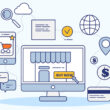Did you know that ecommerce sales in 2018 came in at $2.842 billion, and it is estimated to top $3.453 billion in 2019? Also, ecommerce predictions are that 95% of purchases will happen through online stores by 2040. These stats clearly show that the ecommerce industry will only grow in the foreseeable future.
But this industry has its challenges as well. A number of online store marketers complain that their biggest challenge is the fact that they don’t interact with their customers in person.
Luckily, they can always engage in email marketing to build long-lasting relationships with their customers. Below you will find the most valuable tips to take your ecommerce emails to the next level.
1. Start with the right Email Marketing Subject Line
Your subject line is the first thing that your customers see while checking their inbox. For this reason, you should spend most of your time working on your subject line.
Since human attention span is only getting shorter, your subject line has only a few seconds to get people hooked. If it has too many overused elements or fails to grab customers’ attention, your email will end up in the trash folder without even getting opened.
To optimize your email subject line, try the following tips:
– Avoid overused words (including sales words).
If you want to stand out from your competition, don’t do the same thing everyone else does. This means you should avoid using words like free, sales, reminder, etc.
– Keep it short.
According to Marketo, the optimal length for email subject lines is 41 characters or 7 words. This is about 10 characters fewer than the average subject line.
– Don’t promote too early.
Even though your subject line should contain a punchline and promote your product, try not to use promotional subject lines in each of your emails.
This means that you should avoid overly promotional phrases, exclamation marks, and especially all caps.
– How about questions?
Questions entice curiosity, so subject lines framed as questions generally have a higher open rate.
2. Next, Email Design
Once you have optimized your email subject line, it is time to focus on the design of your email. If your email has only text without branding elements and images, it will most likely be marked as spam.
Why? Because people won’t know who the email is from.
On the other hand, you shouldn’t include too many visual elements. Instead, try to strike the sweet spot between the email copy and visuals (high-quality images, animated GIFs, interesting layouts).
Pro tip: If you want to use high-quality product images in your emails, your best bet is to use clipping path services.
3. Create a Converting Email Copy
Your email copy needs to be simple and to the point. Since your customers have already subscribed and agreed to receive promotional emails from you, there is no need to overcomplicate things.
However, there are some effective marketing email templates and tips that you can use to create an email copy that converts.
– Use psychology.
This means you should be using fear of missing out such as time-limited discounts, scarcity, and urgency. Also, including social proof in your emails will encourage people by telling them that you have already helped their peers.
– Send relevant and personalized emails.
Targeted marketing is always better than generic marketing. Try to segment your customers based on their buyer’s journey stage, demographic, and so on. Relevant emails have much higher open and click-through rates, so make sure that segmentation is an integral part of your email marketing campaign.
– Encourage action.
After your subject line, a call to action is the most important part of your email. It is the CTA that gets subscribers to convert and make a purchase or visit your website again. Again, just like in the subject line, use original phrases, different than those everyone else uses, and you will have much more success in converting your customers.
4. Send Abandoned Cart Emails
Photo by Oleg Magni from Pexels
Some customers log in to your website, add items to their basket, and then just leave. Why does this happen? Probably because your checkout process is not optimized, but that is a topic for another article.
When customers abandon their cart, you should send an abandoned cart email, as it can help you recover a part of this loss. According to Omnisend, 46.1% of people open cart abandonment emails, 13.3% click inside the email, and 35% of those who click actually end up making a purchase.
If you want to start sending abandoned cart emails, know that there are two options:
– Abandoned cart email – sends customers a reminder about the items they left behind, usually within one day of the abandoned cart. This email can be a part of an abandoned cart series.
– Abandoned cart series – encourages customers to complete their purchase through a series of reminders. These follow-ups are sent three to five days after the customer has abandoned their cart and they offer a discounted rate for the product.
Whatever option you choose, you should be using automation to send abandoned cart emails, as there will be a lot of abandoned carts. If you have a plan with one of the top email marketing services, then automation should be included in your plan.
5. Send Up-sell and Cross-sell Emails
Unlike abandoned cart emails, which are sent to customers who have left their carts, up-sell and cross-sell emails are sent to those who have actually purchased an item. The goal of these emails is to sell them more products.
There are a few ways to approach up-sell and cross-sell emails:
– Product follow-up
After a customer buys any product from your online store, send them a follow-up message. This email should include similar products or products which are often bought with the item the customer bought.
– Category follow-up
When a customer purchases a product from a specific category, send them an email to promote related items. Typically, online stores send this type of email after someone has bought an item from a campaign.
For example, if someone has bought a product from a collection ‘Christmas Gifts’, send them a follow-up email with a collection ‘Gifts for Valentine’s Day’.
– Receipt follow-up
Now, this one is fantastic. Since a great majority of people open receipt emails, you can use them to promote offers and discounts for recommending friends. Also, you can ask them for a review of the product, but make sure that they have access to your return and exchanges policy if they need it.
If you want to come up with more follow-up strategies in your specific niche, monitor competitor’s email to see what they do. Then use the same strategy or improve it to stay ahead of your competition.
6. Reward Your Customers
Photo by Porapak Apichodilok from Pexels
Who doesn’t like gifts? A gift is a sign that you care about someone. And as an online store, you should definitely show that you care about your customers.
Now, a lot of businesses reward new customers, which is perfectly fine. But it is your loyal customers that your business would not survive without.
For this reason, your goal should be to create a customer loyalty program, using exclusive offers to invite customers who have engaged with your emails in the past. This will nurture your relationship with them and keep them coming back to your emails – and your online store.
Another thing you can do is reward customers for referring your online store to their friends. Your satisfied customers are your best marketing channel. When they refer you to friends, this is the ultimate social proof. This makes these new, prospective customers much more likely to buy from you.
To reward your customers for referring you, give them a discount on your products. Not only will this incentivize referrals, but it will also encourage referring customers to come back and use the discount to make a purchase.
Bonus Tip – Give Them a Lot of Chances to Sign Up
All of the tips mentioned above are great, but if you don’t get your website visitors to subscribe, you won’t see the expected results. That is why the first thing you need to learn is how to get more email subscribers.
It is important to use all the opportunities to get leads to subscribe to your email list for your email marketing. And now you probably think that it is enough to include forms in your sidebar, footer, and pop-ups. But it’s not.
As the matter of fact, there are additional places on your website where you can get your leads to subscribe:
– During the checkout process, as this is the time when they are the most likely to subscribe.
– In transactional emails – this ensures that no leads are lost.
Once you get as many quality leads to subscribe as possible and use all the other strategies listed, you will find that your email marketing ROI will inevitably increase.











These are some tips that actually might work. Can we send photos so that it looks much more interesting?
Insightful guide Dave! ECommerce, email marketing is one of the best ways to increase conversions. Nowadays, interesting is increasing conversion rate through LiveChat and catboats. So this is also the most important way to build up relationships with potential customers.
So good you shared email marketing tips . I have read these tips and glad really these are useful to me for my email marketing .
I dont know much more about email marketing. but i like writing. i will share it with marketing expert and i think it will be very helpful for him.